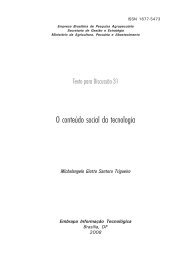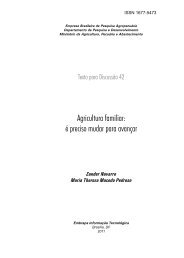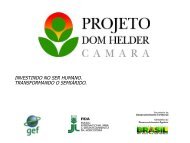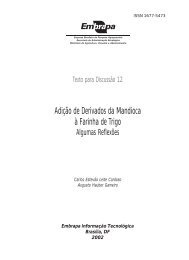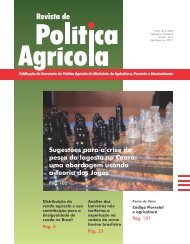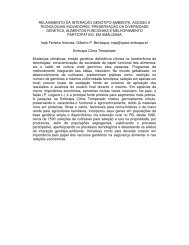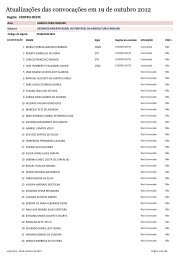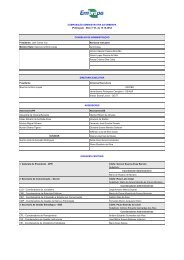Ministry of Agriculture, Livestock and Food Supply - Embrapa
Ministry of Agriculture, Livestock and Food Supply - Embrapa
Ministry of Agriculture, Livestock and Food Supply - Embrapa
You also want an ePaper? Increase the reach of your titles
YUMPU automatically turns print PDFs into web optimized ePapers that Google loves.
Consequently, alcohol fueled more than 90% <strong>of</strong> new vehicles sold from 1983<br />
to 1988.<br />
At the same time the government created the National Alcohol Program<br />
(Proálcool), the world's largest renewable energy program, which included<br />
major incentives for increasing the installed capacity: sugar plantations, sugar<br />
mills, distilleries, <strong>and</strong> storage infrastructure. The new policy brought about a<br />
rapid increase in the sugarcane farming area <strong>and</strong> vertiginous growth <strong>of</strong> alcohol<br />
production, but without disturbing the sugar market supply.<br />
During the 1980-1985 period, the learning process <strong>and</strong> technological<br />
development received an added thrust. Productivity gains in agriculture <strong>and</strong><br />
raw material processing enabled a noteworthy reduction <strong>of</strong> the alcohol<br />
processing costs. There was also remarkable improvement in the efficiency<br />
<strong>of</strong> alcohol engines, which increased the population's reliance on these<br />
vehicles.<br />
As petroleum prices began falling abruptly from an average value <strong>of</strong><br />
over US$ 27.00/barrel in 1985 to less than US$ 14.00/barrel in 1986, the<br />
government was unable to maintain the alcohol price incentives8 .<br />
Hydrated alcohol consumption continued to rise, but the 1989-1990 supply<br />
crisis shook the population's trust in this fuel <strong>and</strong>, consequently, in alcohol-driven<br />
automobiles, whose sales fell from 52.5% in 1989 to 11.55% in 1990.<br />
After the crisis, when sales were beginning to recover (in 1992 <strong>and</strong><br />
1993 alcohol fueled vehicles accounted for over 25% <strong>of</strong> the fleet, on average),<br />
new technological st<strong>and</strong>ards definitely placed alcohol cars at a disadvantage:<br />
the concept <strong>of</strong> 'world car' <strong>and</strong> the new engines <strong>of</strong> up to 1,000cc piston<br />
displacement. Since the price ratio did not favor alcohol, the automobile industry<br />
concentrated its research on producing more economic gasoline vehicles,<br />
which accounted for 75% <strong>of</strong> sales in 1996, while alcohol automobile sales<br />
went down to less than 1%.<br />
In order to prevent a collapse <strong>of</strong> the entire alcohol production structure<br />
in the country, the government determined in 1993 that the gasoline-alcohol<br />
mixture should contain 22% <strong>of</strong> anhydrous alcohol. Alcohol sales still continued<br />
to rise until 1997 <strong>and</strong> by 2000 the decrease in hydrated alcohol consumption<br />
was greater than the increase in anhydrous alcohol consumption. Total alcohol<br />
use grew again beginning in mid 2001, when the use <strong>of</strong> anhydrous alcohol<br />
was greater than the absolute drop in hydrated alcohol consumption.<br />
8 A new decree increased the alcohol to gasoline price ratio to 75% in 1986. This percentage is the<br />
closest possible to the vehicular power ratio between the two fuels.<br />
68



